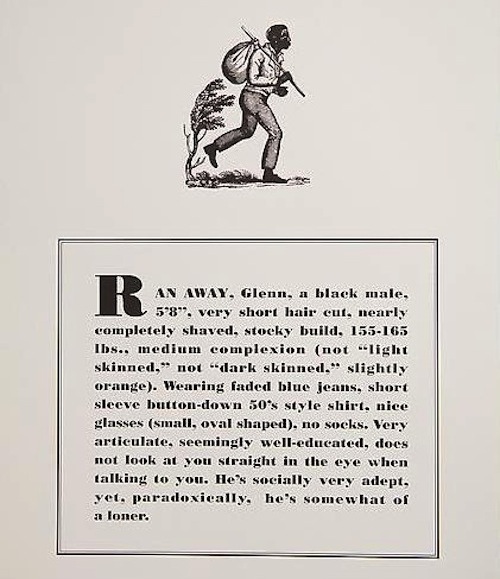Our Slaves: Meditations on the Traffic of Black Bodies in Print (Part 2 of 2)
BY Roger Reeves

I want to think through these questions raised in my last post a bit differently than Saidiya Hartman and Toni Morrison. Their investigation tends to focus upon the playing in the dark archive of slavery by white writers and artists. I am interested in locating the discussion of the trafficking of black bodies in print in the African-American canon. (If I were a real blogger, I would figure out how to fasten a picture of Kara Walker’s work right here. And in another iteration of this blog-essay-meditation-speculation, I would discuss Walker’s work alongside these poets. But the sky is falling, and there are miles to go before I sleep). I am interested in how black writers, specifically black, contemporary poets, put black bodies to work. What do these printed black bodies presence, and concomitantly what do these black bodies absence? Since this form, the blog, does not require the same argumentative apparatus as the scholarly essay or analytic essay, you will forgive me if I might chase rabbits and clouds and clouds that are shaped like rabbits down holes and around the heavens if need be. Alright then, let’s begin. (Or have we already started?)
*
Let us start with Terrance Hayes’s slave. As mentioned in the earlier blog, “Speculating Darkly, of the Folk Surreal Future,” Hayes’s slave defies culturally-sanctioned narratives of slavery—ones that remind us of the valor famous ex-slaves such as Harriet Tubman and Frederick Douglass. Hayes’s slave, one that would keep his children in bondage as a means of keeping them close, does not reify the fighting, independent ethos of America. Rather, what is reified in Hayes’s slave is the complicated acceptance and disavowal of slavery. Hayes’s slave presences the difficult choice of how to make family in a situation in which making family is untenable and almost inconceivable. Hayes also presences a more nuanced and complicated notion of black subjectivity, a subjectivity that is often reduced even as some scholars and artists seek to presence it for fear of rendering the captive black body as too disorderly, too funky, too diseased.
There’s a fear of the (captive) black body. And often that fear is dealt with via respectability—making or forcing black subjectivity to resemble recognizable family and kinship structures. Or, quite simply, making black life presentable. Hayes’s slave defies respectability; he, the enslaved father, "talks his children out of running away with the bottom of his shoe." Violence, a whoopin,’ becomes his mechanism of love. Hayes neither sanitizes this image; nor does Hayes castigate or critique the image. Moreover, Hayes does not put a black body to work in a manner that some might argue reifies the pathology that is quite often ascribed to African-American families by sociologist like Daniel Moynihan in his infamous Moynihan Report. But Hayes confronts this potential flattening of the complexity of black families in a manner akin to Langston Hughes arguing for showing the beauty and un-beauty of the folk in Hughes’s “The Negro Artist and the Racial Mountain.” I would argue that Hayes’s putting captive, black bodies to work for him does not reify black pathology in the least bit; instead, Hayes renders the complexity of black subjectivity on its own terms. Hayes’s assessment of the enslaved black father—“This is what it means to believe in ascension and fear climbing”—accounts for the difficulty, the complexity, the contradictions, the abjection of slave life and subjectivity. Hayes statement, his assessment allows for black subjectivity to be at multiple places at once, to be both here and there, complete and fractured, transcendent and mired. In putting this black body to work, Hayes challenges popular disseminations of black narratives, of black bodies in print. Even as more and more artists and scholars seek to presence blackness, Hayes does so without translating blackness or black subjectivity. In other words, Hayes does not bring blackness or black subjectivity into order, into the recognizable, into the respectable. Instead, Hayes makes presence an ignored narrative of the archive of slavery.
And in making this moment present, he also potentially offers up a bit more freedom for African-American subjectivity. Quite simply, Hayes offers the reader possibility. Through offering us this captive, black body, one that does not follow the actions of other printed, captive black bodies, Hayes challenges his reader to make room for more nuanced notions of black subjectivity, ones that complicate and defy respectability. Maybe this is how, we, black folks can get free? Here I go again, talking real reckless, but Hayes’s slave might be the folk surreal future we’ve been searching for. Hayes’s slave offers us—the modern reader, the modern black subject—the opportunity to imagine a future in which respectability does not equal freedom.
*
Freedom = abjection = ∑0∞ (black subjectivity1 +black subjectivity2 +….)n = Folk Surreal Future. Is this the quantum equation that gets us free?
Roger Reeves (he/him) is the author of Best Barbarian (W.W. Norton & Company, 2022), a finalist for ...
Read Full Biography

